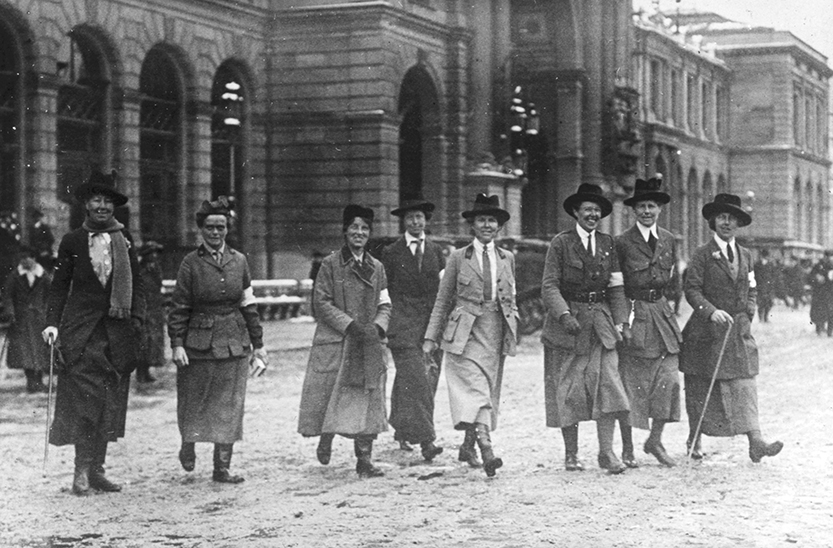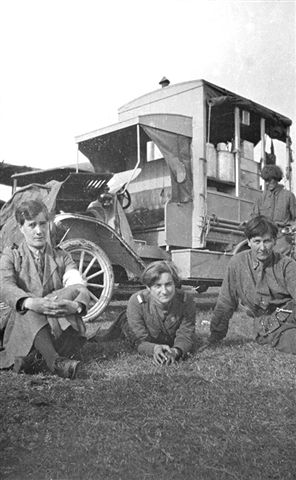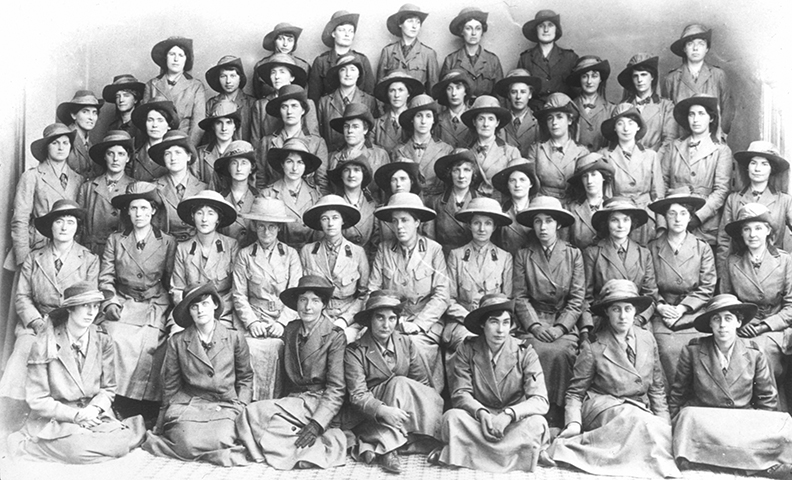Our Skills for the Future Trainee, Maja, gives us an insight into women on the GSA’s Roll of Honour who were part of the Scottish Women’s Hospitals.
Although the majority of the women on GSA’s First World War Roll of Honour worked as auxiliary nurses and orderlies for the British Red Cross, Greenock-born, GSA graduate Betty MacPherson volunteered for an exclusively women-run humanitarian organisation that made a significant, yet until recently, little celebrated contribution during the First World War.

This was the Scottish Women’s Hospitals, founded by surgeon and suffragette, Elsie Maud Inglis. In its membership it also included esteemed GSA alumni and former staff member, Norah Neilson Gray -a Glasgow Girl who produced some of her finest work while posted as an orderly at Royaumont Abbey.

Curiously enough however she is not, unlike her sister Tina Gray (VAD) and GSA contemporary Betty MacPherson, included on the Roll of Honour. Although we can only speculate, this may be due to her resignation as a member of staff in 1917, which took the form of a letter (see image below) that expressed her disappointment and frustration with the school and most probably earned the opprobrium of its management.

This certainly does not mean that her war work, as well as the work of the other 1000 odd members of this bold bande à part should go unrecognised. But who were they, and what is their significance today?
The oft-told story goes that on the outbreak of war founder Iglis and fellow suffragists mobilised, with the financial support of the National Union of Women’s Suffrage Societies to form the ‘Scottish Women’s Hospitals Committee’. After raising a considerable sum, Inglis went to the British War Office to extend their services to the British Army, and was reportedly told by an official to ‘go home and sit still’. Nurses and orderlies were permitted to serve in the British Red Cross but women doctors, a relatively new phenomena, were not considered competent enough for the work. Elsie’s affiliations with the militant suffrage movement wouldn’t have helped either, despite the fact she identified more with their pro-war faction.

Unfazed, Inglis decided to establish an autonomous, all-woman medical organisation that would tend to the wounded of the allied nations, and give testament to the skills and professionalism of women medical practitioners. With an impressive fundraising strategy, the committee raised enough money to set up the first medical unit replete with state of the art equipment by November of 1914. Aided by the French Red Cross, they established a ‘pop-up’ hospital unit on the grounds of old mediaeval French abbey in Royaumont. Staffed entirely by women – from doctors, nurses and orderlies to cooks and ambulance drivers – the unit at Royaumont was in operation until the end of the war, and was soon followed by several others in France as well as Corsica, Malta, Romania, Russia, Salonika and Serbia.
A particularly strong alliance was formed with Serbia, whose soldiers, civilians, and prisoners of war suffered under terrible conditions after Serbia’s military campaign against Austria. A dearth of medical professionals coupled with a typhus epidemic saw many perish in the first year of the war, including several members of the Scottish Women’s Hospital who battled against worsening conditions to attend to their patients. Some, including Inglis, were captured and repatriated; others retreated into the mountains of Albania and Montenegro with the Serbian army, suffering unimaginable hardship.
Although many SWH staff returned to the UK after the war, some remained in Serbia. Dr Kathleen McPhail established a hospital for sick children in Belgrade, and another, Evelina Haverfield, ran an orphanage until her death in 1920.

Considering the many thousands of lives saved by the efforts of the SWH, it comes as no surprise that their work was widely honoured, at least by the allies, after the war. In 1916 the Serbian government conferred upon Inglis the Order of the White Eagle, one of the highest military order achievable in Serbia at the time (she was the first woman ever to receive this award). Dr Frances Ivens of Royaumont Abbey hospital was decorated with both the Croix de Guerre and the Legion d’Honneur by the French government. A memorial fountain was erected in Serbia in Inglis’ memory and the work of the SWH is commemorated to this day in a yearly memorial service in the city of Kragujevac.
In Edinburgh, a memorial maternity hospital was founded in 1925 in honour of Elsie Inglis. This was closed in 1988. Most of the building was demolished in the 1990s, and the remaining subsection has been turned into a nursery attached to a new housing development.
As we seek alternatives to the grand narratives of World War One, the Scottish Womens Hospitals have again entered the imagination of those organisations and institutions responsible for curating the UK’s cultural and social memory. But as the SWH are elevated from history to beloved protagonists of British heritage, it is important that we remember not only the work that they have done, and the barriers they faced. It is important too that we remember the wider ethical landscape of the time that determined the worth placed upon their work; a system of values that, although having shifted, still today, more than ever, demands our continuous revision and re-evaluation.
Resources Used
The Mitchell Archive – Scottish Women’s Hospital Collection: Financial Records (reference TD1734)
Wikipedia The Free Encyclopedia – Elsie Inglis

